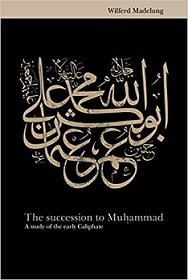The Succession to Muhammad: A Study of the Early Caliphate
 | |
| Author | Wilferd Madelung |
|---|---|
| Language | English |
| Published | 1998 |
| Publisher | Cambridge University Press |
| Pages | 432 |
The book The Succession to Muhammad: A Study of the Early Caliphate investigates the conflict which developed after the death of Muhammad for control of the Muslim community. In this book, Shi'a idea about succesion after Holy prophet has been supported.
About the author[edit | edit source]
Wilferd Madelung (b. 1930) is the German scholar of Islam and Shi'a studies. He has had an important role in introducing Shi'a to the West. After finishing primary and secondary educations, Professor Wilferd Madelung went to the University of Cairo and received B.A. in Islamic History and Literature in 1953. He then continued his higher education in his country and in 1957, received his PhD in Islamic Studies from University of Hamburg. Madelung finished his thesis under German Islamic scholars R. Strothmann and B. Spuler. He was the cultural agent of Western Germany in Baghdad for three years (1958 – 1960) and then continued his scientific life in Islamic Studies.
About the book[edit | edit source]
This book published in Cambridge University Press (November 28, 1998), has 432 pages and best sellers rank of 445,059 in Books.
Wilferd Madelung explores the succession of the first four caliphs following the death of the Prophet. He brings out 'Ali's early claim to legitimate succession, which gained support from the Shi`a, and offers a radical and convincing reinterpretation of early Islamic history after the death of Muhammad.
Abstract of chapters[edit | edit source]
Chapter 1, Abu Bakr: the Successor of the Messenger of God and the caliphate of Quraysh[edit | edit source]
This chapter examines the fundamental account about the assembly at the Saqifat Bani Sa`ida, in which the succession of Abu Bakr to Muhammad was decided. This account clearly reflects the characteristic point of view of Ibn al-`Abbas, and there is no reason to doubt the reliability of the chain of transmitters.
Chapter 2, Umar: Commander of the Faithful, Islamic meritocracy, consultation and Arab empire[edit | edit source]
This chapter is about the Umar b. al-Khattab, Abu Bakr's successor and his government. He had always stood for a rigorous, unconditional backing of the cause and principles of Islam. In the time of Muhammad, he had repeatedly, but unsuccessfully, opposed diplomatic overtures to the Mekkan enemies of the Muslims. He usually confined himself to consulting with the prominent early Mekkan Companions. In the long run, his efforts to curb the power of the Mekkan aristocracy in fayour of the early Companions were only partially successful.
Chapter 3, Uthman: The Vicegerent of God and the reign of Abd Shams[edit | edit source]
This chapter is the story of Uthman's rule which ended after twelve years amid rebellion and with the violent death of the caliph. The grievances against his arbitrary acts were substantial by the standards of the time and widely felt. Towards the end of his reign dissatisfaction and opposition to his conduct appear to have been almost universal except among his kin and close associates. It was only his violent death that, having been turned into a political tool, came to absolve him in Sunnite ideology from any ahdath and make him a martyr and the third Rightly Guided Caliph. Prominent among the virtues (fada'il) credited to him were rather his acts of generous support of Muhammad and the Muslim community from his personal fortune.
Chapter 4, Ali: the counter-caliphate of Hashim[edit | edit source]
This chapter examines the reign of Ali, which by the norms of the early caliphate it lacked legitimacy but the criteria for legitimate rule laid down by Abu Bakr and Umar were irrelevant from his perspective. Ali's rule, to be sure, had not gained popularity in Kufa during his lifetime. The loyalist following that he built up during the final years of his reign, consisting of men convinced that he was the best of Muslims after the Prophet and the only one entitled to rule them, remained a small minority. Umayyad highhandedness, misrule and repression were gradually to turn the minority of Ali's admirers into a majority. But the memory of later generations Ali became the ideal Commander of the Faithful.
Conclusion[edit | edit source]
The death of `Ali, in the midst of preparations for a fresh campaign to Syria, left the course of the civil war in suspense. The succession of his eldest son, al-Hasan, Muhammad's grandson, went ahead without dispute. Ali had on many occasions expressed his conviction that only the Prophet's ahl al-bayt were entitled to rule the Community. The author believes that history, even if it were an exact science rather than a gamble on probabilities and plausibilities, would leave many gaps to be filled only by imagination, which enjoys the colorful. This may easily create the illusion in the mind of the critical historian that plain prosaic reports, be they in the news media or in their historical antecedents, are more likely than anecdotes to be plain, not manipulated fact.